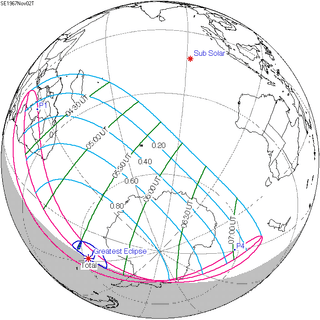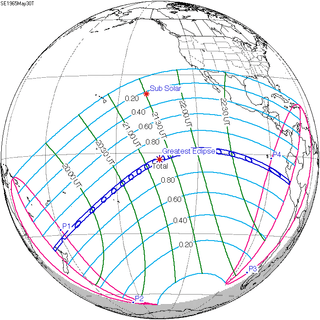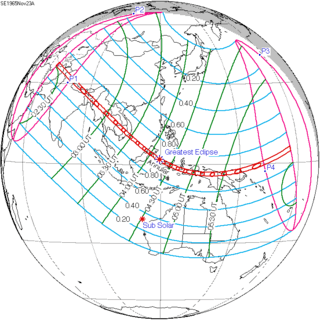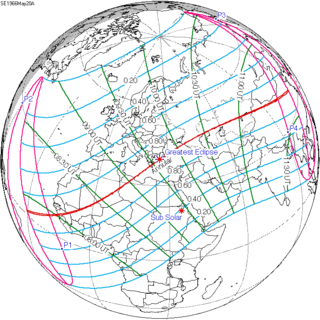Solar eclipse of November 2, 1967
| Solar eclipse of November 2, 1967 | |
|---|---|
 Map | |
| Type of eclipse | |
| Nature | Total |
| Gamma | 1.0007 |
| Magnitude | 1.0126 |
| Maximum eclipse | |
| Duration | - |
| Coordinates | 62°00′S 27°48′W / 62°S 27.8°W |
| Max. width of band | - km |
| Times (UTC) | |
| Greatest eclipse | 5:38:56 |
| References | |
| Saros | 152 (10 of 70) |
| Catalog # (SE5000) | 9437 |
A total solar eclipse occurred on November 2, 1967. A solar eclipse occurs when the Moon passes between Earth and the Sun, thereby totally or partly obscuring the image of the Sun for a viewer on Earth. A total solar eclipse occurs when the Moon's apparent diameter is larger than the Sun's, blocking all direct sunlight, turning day into darkness. Totality occurs in a narrow path across Earth's surface, with the partial solar eclipse visible over a surrounding region thousands of kilometres wide.
Related eclipses
Solar eclipses of 1964-1967
This eclipse is a member of a semester series. An eclipse in a semester series of solar eclipses repeats approximately every 177 days and 4 hours (a semester) at alternating nodes of the Moon's orbit.[1]
Note: Partial solar eclipses on January 14, 1964 and July 9, 1964 belong to the previous lunar year set.
| Solar eclipse series sets from 1964-1967 | ||||
|---|---|---|---|---|
| Ascending node | Descending node | |||
| Saros | Map | Saros | Map | |
| 117 |  June 10, 1964 Partial |
122 |  December 4, 1964 Partial | |
| 127 |  May 30, 1965 Total |
132 |  November 23, 1965 Annular | |
| 137 |  May 20, 1966 Annular |
142 |  November 12, 1966 Total | |
| 147 |  May 9, 1967 Partial |
152 |  November 2, 1967 Total | |
Notes
- ↑ van Gent, R.H. "Solar- and Lunar-Eclipse Predictions from Antiquity to the Present". A Catalogue of Eclipse Cycles. Utrecht University. Retrieved 6 October 2018.
References
- Earth visibility chart and eclipse statistics Eclipse Predictions by Fred Espenak, NASA/GSFC
| Wikimedia Commons has media related to Solar eclipse of 1967 November 2. |
